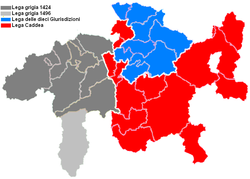
Back Drei Bünde ALS Tres Lligues Catalan Drei Bünde German Tres Ligas Spanish Trois Ligues French Tre Leghe Italian 三同盟 Japanese 삼동맹 Korean Три лиги Macedonian Três Ligas Portuguese
Free State of the Three Leagues | |||||||||||||||||
|---|---|---|---|---|---|---|---|---|---|---|---|---|---|---|---|---|---|
| 1471–1799 | |||||||||||||||||
 The foundation of the Three Leagues:
Grey League, as at 1424
Moesa, joined the Grey League in 1496
| |||||||||||||||||
| Status | Associate of the Old Swiss Confederacy | ||||||||||||||||
| Capital | Chur | ||||||||||||||||
| Government | Republic | ||||||||||||||||
| Historical era | Renaissance, Baroque | ||||||||||||||||
• League of God's House founded | 29 January 1367 | ||||||||||||||||
• Grey League founded | 1395 | ||||||||||||||||
• Grey League government | 16 March 1424 | ||||||||||||||||
• League of the Ten Jurisdictions formed | 8 June 1436 | ||||||||||||||||
| 1450 | |||||||||||||||||
• Closer ties and de facto independence from the Holy Roman Empire | late 15th century | ||||||||||||||||
• Bundesbrief constitution | 23 September 1524 | ||||||||||||||||
| 1798 | |||||||||||||||||
• Annexed to the Helvetic Republic | 21 April 1799 | ||||||||||||||||
| |||||||||||||||||
The Three Leagues, sometimes referred to as Raetia,[1] was the 1471 alliance between the League of God's House, the League of the Ten Jurisdictions, and the Grey League. Its members were all associates of the Old Swiss Confederacy, and as such enjoyed positive relations with the Confederation, which eventually led to the formation of the Swiss canton of Grisons.
The territory corresponds to the core territory of Raetia Curiensis (ruled by the bishops of Chur as Prince-Bishopric of Chur), the early medieval remnant of the Roman province of Raetia prima.
- ^ Wilson, Peter (2010). Europe's Tragedy: A New History of the Thirty Years War. Penguin Books. pp. 159–61, 383–4.
